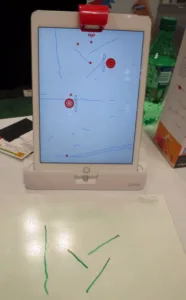I went to the Toy Fair 2015 in New York on February 15th. One thing I saw very little of was toys with displays in them. Instead, since everyone has an iPhone, or so the toy industry assumes, all toys needing a display are of the Bring Your Own Display (BYOD) sort. For example, of the 12 toys selected for the Toy of the Year Award (TOTY), this was the first year that I’d been there and none of the TOTY toys included a display.

iOS is the operating system of choice for the apps from BYOD toy developers. Commercially, since there are actually far more Android devices out there, they all need to produce Android versions of their apps. Another reason why Android is needed is that toys are very price sensitive. A parent may buy an iPad for himself but a lower cost Android tablet for his child to use as a toy. A couple of vendors I talked to were showing off their released iOS app and said that Android was in Beta and would be ready in time for Christmas.
In the past, many of the most interesting BYOD systems at the Toy Fair used the smartphone or other device as a remote control for things like dinosaurs, toy race cars or drones. Most of these apps were based on Wi-Fi. This year I saw more variety in the BYOD use where the display was a more inherent part of the toy and not just a remote control. Many of these newer apps were also based on Bluetooth, rather than Wi-Fi.
Osmo mirror and base, an iPad and the Newton app
One deceptively simple example of this was from Osmo. This toy was a mirror and a base for an iPad (Apple only at this point). The mirror fitted over the selfie camera and folded the image path downwards. The base allowed the iPad to stand up with a slight angle. This allowed the camera to image the tabletop area in front of the iPad. Objects and drawings in this area were imaged and could control what happened on the screen. Osmo ships with the mirror, base and three apps. My favorite of the three was Newton. In this app, virtual bouncing balls streamed down the screen. Draw something on the tabletop playing field, or leave an object in the field and the camera would image it and the balls would bounce off it. You know those strange artworks with bouncing steel balls in theaters and bus stations? This was a virtual version of them.
Like Osmo, most of the toys shown at the Toy Fair were either ready to ship now or would ship in time for the coming Christmas toy season. One exception to this was from IdentiToy (Fremont, CA). This company was showing a Bluetooth module that could be placed on a tablet screen and report its position back to the tablet software. The module did not use the tablet’s touch screen for position location and did not actually need to touch the screen. The module was demonstrated at the toy fair using a clear plastic base covering the screen that was compatible with Lego building blocks. The software on the tablet would sweep lines across the screen that the module detected optically and then reported its position to the software via Bluetooth Low Energy. The software could manage up to nine of these modules at a time. Arjuna Karunaratne, CEO of IdentiToy, said the company was at the Toy Fair hoping to attract toy makers interested in making BYOD interactive toys to its technology.
 Boogie Board Sync with Samsung Smart Phone (Image on Boogie Board and phone don’t match because of, presumably, the noisy Bluetooth environment)
Boogie Board Sync with Samsung Smart Phone (Image on Boogie Board and phone don’t match because of, presumably, the noisy Bluetooth environment)
One intriguing gadget – it’s more than a toy – that I saw at the Toy Fair was the Sync from Boogie Board (Kent, Ohio). Boogie Board makes a series of LCD displays, typically tablet sized, that can be written on with a stylus. Like the Etch-a-Sketch from Ohio Art (which was also there), most Boogie Board products are write and erase – there is no way to store the image drawn on the screen. The Sync is different. You just press a button and the image you have drawn is saved to internal memory. The image can then be erased and the Sync used for the next set of notes, drawings or doodles. Once you have erased it, there is no way for the Sync to re-write the image on the tablet. Boogie Board does offer apps for iOS and Android to upload the images to your smartphone or tablet via Bluetooth. There is also software in English and Japanese for Microsoft Windows (Vista, 7, 8, 8.1) and the Mac (OS X v10.8 and above). One of the features of this software is a virtual whiteboard mode. This allows you to display images drawn on the Boogie Board Sync’s writing surface in real-time onto a PC monitor or projector.
The Toy Fair, a product of the Toy Industry Association (TIA), is the largest toy show in the Western Hemisphere. This year it had 30,000 registered “global play professionals” and a record-breaking 422,000+ net square feet (39,205 m²) of exhibit space. Toy Buyers get special consideration at the show – this is the show where US toy stores order much of their inventory for next fall’s holiday selling season. The TIA is a trade group with 750 member companies that collectively provide about 90% of the toys sold in the US. – Matthew Brennesholtz

